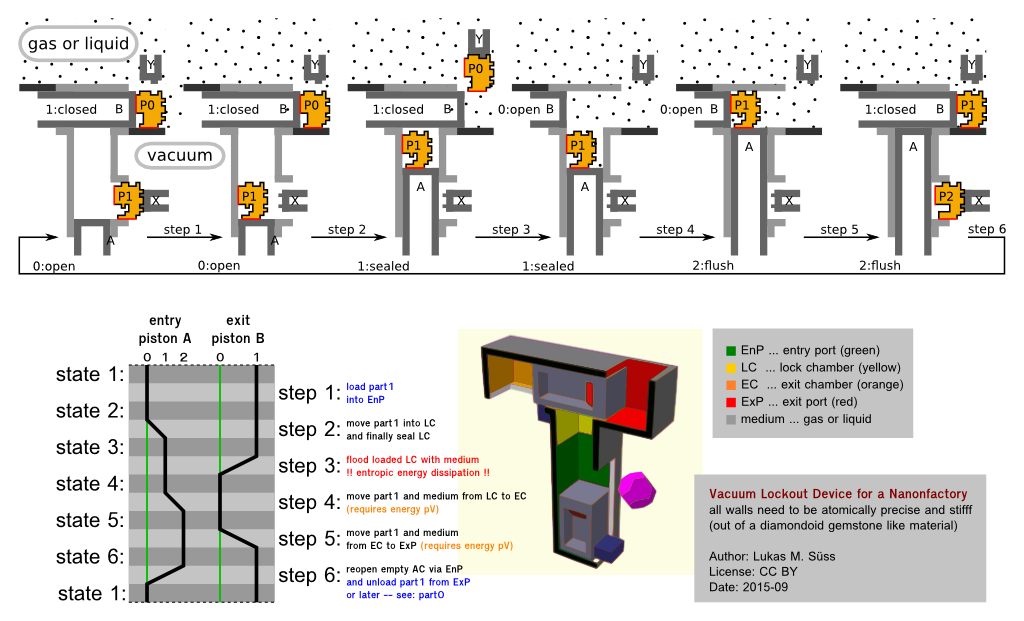Vacuum handling
This is about creating and maintaining vacua in advanced gemstone based productive nanosystems like nanofartories.
Contents
[hide]Locking (arbitrary shaped) parts out
At some place in the assembly levels (above Level II) products or fractions of them need to be locked out out of the vacuum area while keeping the interior perfectly gas free. This can be done with two pistons like depicted below. This method doubles as a pump for stray gas molecules. Import of parts (locking them in) is not possible here. Openings are wide enough to allow free molecular flow. (The pump stages need to be around as thick as the corresponding assembly layers below)
To get the parts through the airlock at some point one has to let go of the parts. To keep the parts in machine phase one can designed them to have three surfaces normal to each other at their outermost positions (red lines in graphic) so they stick in a corner by Van der Waals forces. Alternately for parts filling almost the whole chamber conical re-centering could be used to get the parts back into machine phase. Truncated octahedral shaped microcomponents with flat square faces and possibly interlocking hexagonal faces would e.g. be easy to lock out.
If not only dust free-ness but also vacuum is kept till the macroscopic outlet this waste free expulsion mechanism may not work because of wall bending & buckling at the macro scale [To inverstigate] (fractal fir tree interlocking sliders may help). An other more wasteful proposal was to enclose the whole products in sausage shaped balloons (inflated by e.g. argon) which come one after another through a cylindrical output port and keep a tight seal at all times. This is more likely to work and can be designed without exposure of dangerous atomically sharp edges.
In an convergent assembly design if airlocks are installed at all assembly levels and the factory supports it it could be merged and split by hand. E.g. Take of the top stage and then split up the sub stages. A direct assembly design that supports it could be split at any perceivable ratio.
Locking (arbitrary shaped) parts in
It is more difficult to lock in parts. This reverse direction isn't a necessity for t.level III APM with its mechanosynthesis done in vacuum. A lot recycling can probably be done with passivated microcomponents in a non vacuum environment.
The ability to lock parts back in might be useful for tuning / repair / DME recycling on a sub microcomponent level (see assembly levels).
To get parts as clean as possible before locking them in again several measures can be taken:
- cleaning the un-disassembled product with very high pressure noble steams
- tag surface microcomponents as potentially dirt contaminated and scrap the hole shell (wasteful but better than scrapping the whole un-disassambled product)
- keep internals of porducts isolated (does not work if the product itself is a filter)
- filtering argon from air and blowing it outward in a pre-chamber forming a dust seal
To lock parts in by shearing off gas molecules is not an option since the parts can be arbitrarily shaped.
Still extremely low probabilities of remaining trapped gas molecules can be archived by usage of various pumping methods.
- using pistons / bellows that have a multiple volume of the handled parts
- operating pistons multiple times
- stacking airlocks in stages.
- additional usage of microscale turbo-molecular pumps (Nanosystems: Section 11.4.3.)
- exposed unpassivated surfaces
- slight heating if the nanofactory and product allows this (and when no remnants of temperature sensitive t.level I are included)
Examples for positive displacement pumps:
- piston pumps - advantage of high throughput area
- bellow pumps
- scroll pumps
- processing cavity pumps
alternate vacuum methods
- blowing up a vacuum bubble by either an extendable flexible skin or sliding blocks - Nanosystems: Figure 14.2. & Figure 14.3.
- extruding a cuboid out of a cuboid - this was an idea for assembler self replication - Nanosystems: Figure 14.6. & KSRM ...
- usage of some noble gas instead of vacuum to blow up non-stiff enclosures
Related
External links
On Flickr:
